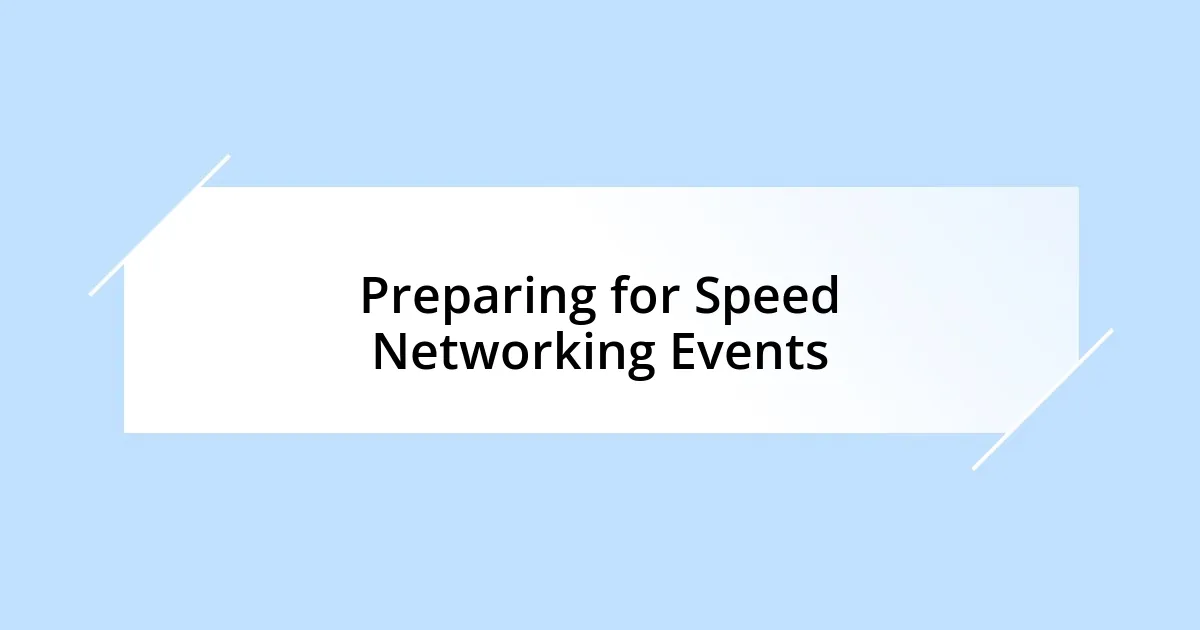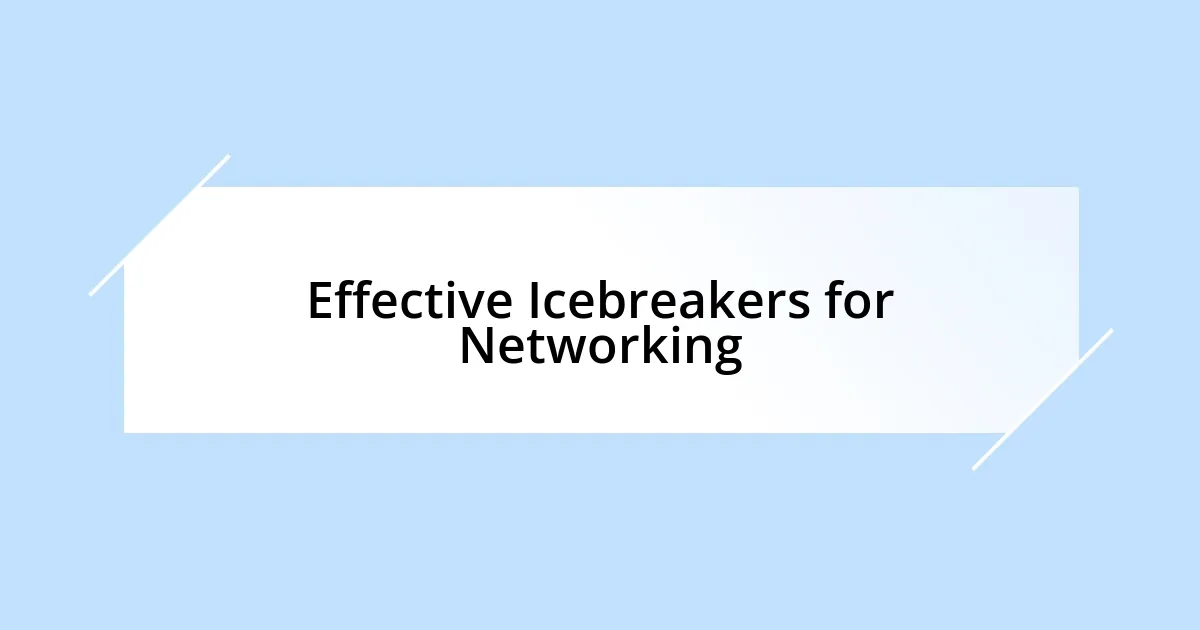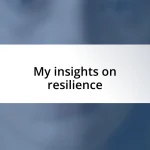Key takeaways:
- Speed networking enables quick relationship building and enhances networking skills through concise communication.
- Preparation is key: set clear goals, research attendees, and practice your elevator pitch to make the most of networking opportunities.
- Effective icebreakers, genuine compliments, and shared stories can facilitate deeper conversations and connections.
- Follow up promptly with personalized messages to nurture relationships and keep momentum from initial interactions.

Understanding Speed Networking Benefits
Speed networking offers a whirlwind experience for anyone looking to expand their professional circle. I remember my first event vividly; the energy in the room was palpable, and I found myself connecting with diverse individuals in such a short time. Have you ever realized how many opportunities can spark from just a few focused minutes?
One of the most remarkable benefits is the ability to build relationships quickly. In my experience, the fast pace forces you to communicate your value succinctly, honing your networking skills. I’ve noticed that it encourages genuine interactions, making it easier to remember not just names, but the stories and passions behind them.
Moreover, the varied nature of attendees can open doors that you might not have considered before. At one event, I met someone from an entirely different industry, which led to an unexpected collaboration. Isn’t it fascinating how a single encounter can redirect your career path? The beauty of speed networking lies in its potential to create serendipitous moments that can lead to exciting opportunities.

Preparing for Speed Networking Events
Preparing for a speed networking event can feel a bit overwhelming, but I’ve found that a solid strategy makes all the difference. I like to start by setting clear goals for what I want to achieve. This not only gives me a sense of direction, but it also helps me stay focused during the whirlwind of conversations.
Here are a few tips that have worked well for me when preparing:
- Research attendees: Knowing who will be there allows you to identify key connections ahead of time.
- Craft your elevator pitch: Keep it concise, engaging, and reflective of your personality.
- Practice active listening: Your goal is to build relationships, so make the effort to truly hear what others are saying.
- Prepare your follow-up plan: Before the event, think about how you’ll connect with new contacts afterward.
- Dress comfortably yet professionally: Feeling good in what you wear boosts your confidence and leaves a positive impression.
On the day of the event, I try to arrive early to get a feel for the atmosphere. I once walked into a venue buzzing with excitement, and it reminded me of the first day of school—full of anticipation but also nerves. Adopting a positive mindset can really help you relax, allowing for more authentic conversations that resonate with others.

Establishing Your Networking Goals
Establishing your networking goals is a crucial step that can greatly enhance your speed networking experience. I’ve found that being specific about what I want to achieve helps me steer conversations towards meaningful connections. For instance, I once attended an event with the goal of finding a mentor, which transformed my approach and interactions that day.
When you think about networking objectives, it’s essential to consider both short-term and long-term goals. A few years back, I aimed to secure immediate introductions for potential collaborations, which felt exhilarating. However, I soon realized the importance of nurturing these relationships over time, leading me to expand my goals further. Balancing both types of goals allows you to stay engaged while making valuable connections that can span across time and industries.
I encourage you to write down your goals and take a moment to reflect on them before the event. Visualizing your success eases any pre-event jitters. I still remember the day I pasted my networking goals on a sticky note in my notebook, which served as a constant reminder during conversations. Anchoring yourself in clear intentions will not only guide your interactions but also provide you with a sense of accomplishment as you check off your objectives after the event.
| Short-Term Goals | Long-Term Goals |
|---|---|
| Identify potential collaborators | Develop a mentor-mentee relationship |
| Expand your professional circle | Establish a network of industry experts |
| Gather insights on specific topics | Gain reputation within your industry |

Effective Icebreakers for Networking
When it comes to effective icebreakers, I’ve learned that asking open-ended questions really helps kick off conversations. For example, I once asked someone, “What’s the most exciting project you’re currently working on?” The answer led to an animated discussion that revealed shared interests, allowing our connection to flourish. Isn’t it fascinating how a simple question can open the floodgates to deeper dialogue?
Another approach I enjoy is sharing a light, relatable story. I remember attending a networking event where I jokingly mentioned my clumsiness on the dance floor. It brought a smile to people’s faces and made them feel at ease with me, turning strangers into friends. Who doesn’t appreciate a laugh? It’s these little moments of vulnerability that can humanize a professional setting.
Lastly, incorporating a compliment can go a long way. On one occasion, I noticed a fellow attendee had an interesting lapel pin, so I commented on it. This small gesture not only brightened their day but also sparked a conversation about their interests and hobbies. Isn’t it amazing how authentic compliments can break down barriers and pave the way for genuine exchanges?

Mastering the Art of Follow-Up
Following up after a speed networking event is where the magic truly happens. Personally, I’ve found that sending a tailored email is a golden opportunity to remind someone of our conversation. I once reached out to a new contact with a simple, “I enjoyed our chat about sustainable design—I’d love to hear more about your innovative project in that space.” This personal touch connected us further and built on what we had started.
Timing is everything, though. I’ve learned that following up within 48 hours feels optimal; it keeps the momentum going while conversations are still fresh in both parties’ minds. There was a time when I waited too long to reconnect with someone after an event, and by the time I did, our initial spark had fizzled. Have you ever experienced that awkwardness of trying to rekindle a conversation days later? I know I have, and I wouldn’t wish that feeling on anyone.
Keeping it concise is crucial as well. I often opt for a brief message that recalls our discussion, then suggest meeting for coffee or a virtual chat. For example, I recently wrote, “Our talk about digital marketing trends inspired me to dig deeper into your recommendations. Are you free for a coffee next week?” This not only shows genuine interest but also paints a clear pathway for next steps. Crafting these small, intentional follow-ups has transformed my networking efforts into lasting relationships. What about you? How do you approach following up?

Leveraging Technology in Networking
When it comes to leveraging technology in networking, I’ve found that utilizing social media platforms can be a game changer. For instance, after meeting someone at a speed networking event, I quickly connected with them on LinkedIn. This not only solidified our interaction but also opened up avenues for sharing insights and industry content. Isn’t it incredible how a simple connection can lead to a wealth of knowledge exchange?
Virtual networking tools have also transformed my approach. I remember attending an online event where I used breakout rooms to interact with different participants. I felt a rush of excitement when I flipped from one room to another, meeting diverse professionals from around the world. It was a refreshing change and truly showcased how technology can expand our networking horizons beyond geographical limits. Have you noticed how different the atmosphere is in virtual spaces compared to in-person settings?
Additionally, I often use digital business cards through apps to share my information instantly. Instead of fumbling for a physical card, I can simply tap my phone, and voila! My contact details are shared effortlessly. This not only saves time but also makes a lasting impression. I still remember the look on someone’s face when I introduced my digital card—it was a mix of surprise and intrigue. Doesn’t it feel good to stand out in a crowd, especially when technology enhances our interactions?

Measuring Your Networking Success
Measuring the success of your networking efforts goes beyond simply counting business cards or LinkedIn connections. I often reflect on the quality of interactions I have rather than the quantity. For instance, after a recent event, I sat down to evaluate which conversations felt meaningful and had the potential for collaboration. It was eye-opening to realize that, for me, success isn’t just about making connections; it’s about nurturing relationships that resonate.
I also find it helpful to track my follow-up outcomes. After reaching out, I make a note of whether someone responded positively, if we scheduled a meeting, or if they introduced me to another contact. This feedback loop has allowed me to refine my approach; I can see what strategies yield the best results. Have you ever thought about how measuring success could lead to even stronger connections? Reflecting on this helps me adapt and enhance my networking strategy over time.
Lastly, I keep a journal to jot down key takeaways from each interaction. I recall a conversation about a developing trend in my industry that changed the way I approached my projects. Noticing the impact of specific discussions helps me understand my networking landscape better. I invite you to consider keeping a record of those discussions that spark something within you; you might be surprised at how they shape your professional journey.














